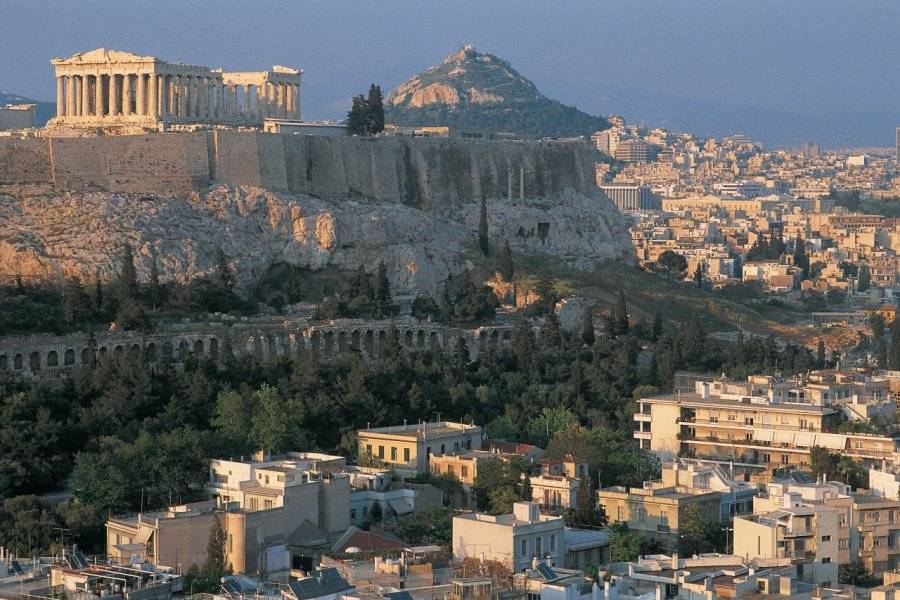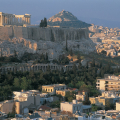The monuments of the Acropolis, the universal symbols of Athens, are the cultural heritage that ancient Greece bequeaths to humanity.
The Acropolis is a naturally fortified site on three of its slopes, forcing the visitor to access it from the west. This privileged position encouraged the man to settle there since the Neolithic period: traces of dwellings were found on the northwestern slope. The city developed in an important way until the Mycenaean period and, at the beginning of the XIIIth century B.C., the top of the hill was fitted out to build the king's palace. It is at this time that the Acropolis was equipped with its first ramparts which surrounded completely the rock and were reinforced by a bastion of which there remain vestiges under the small temple of Athena Nike. Also, a secret underground cistern was built which allowed the city to be supplied with water in case of siege. The Mycenaean remains that have been found on the Acropolis are rare because of the large number of buildings that were built there later.
By crossing the entrance of the site of the theater of Dionysus, you enter the cradle of the ancient theater, on the southeast side of the acropolis of Athens. It obviously owes its name to Dionysus, god of wine and drunkenness. The great festivals of the Dionysias were held there every year in his honor (ritual songs, dances and ritual sacrifices and other theatrical performances). The greatest tragedians and comedians began there. At the origin of the dramatic art, the festivals were organized in the theater and gave place to mimed, sung and spoken scenes. The first theater built on the site must have been basic and simply supported by some earthen embankments. It was not until the5th century BC that the theater took on the appearance we know today. Authors such as Sophocles, Aeschylus, Euripides or Aristophanes have trodden the "boards" of this theater. Completed towards 330, it accomodated thereafter the plays of the Romans, who modified appreciably the monument: it is of this time that date the bas-reliefs which decorate the bottom of the scene, representing the birth of Dionysos. The theater welcomed gladiators and even water games, with a stage transformed into a basin for the occasion. It could shelter from 14 000 to 17 000 spectators, the seats with back of the first row were reserved by right to the notables and patrons of the theater. The most important place, the middle seat in the first row, was reserved for the priest of Dionysus.
Odeon of Herod Atticus. Going up from the theater to the entrance of the Acropolis, you find yourself at the top of the odeon of Herod Atticus. This monument, probably completed around 161 AD, has all the characteristics of a Roman odeon, with the columns at the back of the stage framing niches housing statues. Its exceptional state of preservation makes it one of the most interesting monuments of the site and cultural events are still held within its walls today. Herod Atticus, a native of Marathon and heir to a large fortune, spent a lot of money to build several public buildings throughout Greece. This one was intended for musical and dramatic competitions. 5,000 people could stay in it, its walls were covered with marble slabs as well as the floor which also included mosaics. The roof was probably made of cedar wood.
The door Beulé. This door marks, nowadays, the entrance of the Acropolis. It owes its name to the French archaeologist who, in 1852, carries out excavations on the site. It is one of the two gates of the fortified enclosure dating from the third century AD, located at the west of the hill. It is very likely that these fortifications were built after the Herulian invasion in 267 AD, in order to protect the Acropolis from possible enemies. From that time on, and until the 19th century, the Acropolis was again transformed into a fortress.
The temple of Athena Nike is on your right as you climb the stairs. It was built under Pericles on the ruins of the Mycenaean bastion. The work was begun in 437 BC, but interrupted by the Peloponnesian War and completed in 427-424 BC. The temple consists of a secos (residence of the god) and two ionic colonnades on the east and west facades. The Ionic friezes represented in the west the assembly of the twelve gods. The one in the east, with the Athenians fighting against the Persians and Greeks, is in the British Museum.
The Propylaea. This colonnade was built between 437 and 432 BC under Pericles to signify that the Acropolis belonged to the people of Athens. The building was revolutionary for its time: it was the first propylaeum to present a facade in the form of a temple. The central part of the Propylaea consists of two porticoes with six columns, one opening onto the interior of the sanctuary and the other onto the exterior. The spaces between the columns were used as a place of access for the faithful, while the central passage allowed the passage of animals during the sacrifices.
The pedestal of the monument of Agrippa. On the way, notice to the west of the Propylaea, and while going up the great staircase, this large pedestal, in marble coming from the mount Hymette. It was used as a base for a statue of a quadriga erected in 178 B.C. by king Eumenes II of Pergamon, to commemorate his victory in the Panathenean Games. In 27 BC, this statue was replaced by a monument dedicated to Marcus Agrippa, benefactor of the city, who, among other things, financed the construction of the Odeon on the site of the Roman agora.
The Parthenon has some architectural originalities used by the builders to give it the grandiose appearance that it has today. The horizontal surfaces of the temple are not flat but convex, the columns taper upwards and the corner columns have a slightly larger diameter than the others. All this to correct the natural deformations of the human eye and thus give the building all its majesty! The external Doric frieze included no less than 92 metopes, all sculpted. On the east side was represented a gigantomachy, that is to say a fight between the gods of Olympus and the giants. In the west, there was an amazonomachy, that is to say a fight between the Greeks and the Amazons. In the south were represented fights against centaurs and in the north scenes of the Trojan war. Some metopes are still in place, others are exposed in the Louvre, the British Museum or the Acropolis Museum. The Parthenon was also decorated with two pediments (east and west) which represented, on the west, the dispute between Poseidon and Athena for the possession of Attica and, on the east, the birth of Athena. But the most famous sculpted piece of the Parthenon is certainly its interior frieze, work of Phidias. On 160 meters length, it represented the most famous cult event of Greece at that time: the great Panathenes. These festivals, which lasted one week, included musical and athletic contests, their point of culmination being obviously the great procession which followed the sacred Way from the Ceramics to the large wooden statue of Athena Polias of the Erechtheion in order to give him a new peplos (tunic). The handing-over of the peplos was followed by the sacrifice of a hundred animals and a feast in which all the citizens took part. The frieze of Phidias represents 360 characters and a crowd of animals all heading towards the east where the ceremony took place.
With the exception of a few plates, most of the frieze is scattered between the British Museum, the Louvre and the Acropolis Museum.
Temple of Rome and Augustus. Behind the Parthenon, on the west side, are the irregular foundations of a small circular monument (10.5 m by 13 m) built during the Roman domination, dating from the end of the first century BC. According to the inscription engraved on the entablature of the building, it was a temple dedicated by the Athenians to the goddess Rome and to Octavian Augustus. The temple consisted of a circular colonnade of nine Ionic columns imitating those of the Erechtheion.
Sanctuary of Zeus Polias. There was also, on the hill of the Acropolis, a small sanctuary dedicated to Zeus, the king of the gods of Olympus, located a little more north than the temple of Rome and Augustus. We owe the existence of this sanctuary to the texts of Pausanias, the famous traveler of Antiquity (IInd century AD), as well as to some notches found on the highest point of the site. It was a temple where festivities in honor of Zeus were celebrated, of a very local character, the Diipoleia.
Foundations of the ancient temple. Between the Erechtheion and the Parthenon remain the foundations of the archaic temple of Athena built in 570-560 BC. According to archaeologists, it was a Doric temple built in place of a temple of the geometric period, itself built on the site of the Mycenaean palace. Started under Pisistrates, this temple was destroyed by the Persians in 480 BC. Under Pericles, it sheltered, in its secos, the treasure of the Attic-Delian alliance brought by Athens.
The Erechtheion, mythical temple on the famous Acropolis, is one of the most sacred of the hill and of the whole city. North of the Acropolis, a jewel and masterpiece of Ionic art, the elegant Erechtheion was built in the5th century BC on the very spot where, according to legend, Athena and Poseidon fought for the possession of Athens. Next to this temple, Athena's sacred olive tree grew and the salt water well was located, a gift from Poseidon whose trident left a mark on the north wall of the building. The architect of the Erechtheion remains unknown, but he knew how to exploit the irregularities of the ground to build a whole of several buildings on various levels. In this temple were worshipped several deities: Athena Polias, but also Poseidon and others still linked to the legendary history of Athens, like Erechtheus to whom the temple owes its name. The temple is decorated with four porticoes on each of its sides: the one on the south-east side, certainly the most known, is that of the Caryatids. The Doric columns are replaced by female figures of perfect grace when one knows the weight that weighs on their heads. In fact, it is their thick hair and the numerous folds of their clothes that reinforce the structure and allow the whole to remain standing. The ones you see in place on the monument are only casts: of the six korises, five are visible in the Acropolis museum, the sixth being in the British Museum, in London. One day, perhaps, they will be again joined together as claimed by the great majority of the population. This apple of discord between Greece and Great Britain has nothing of a myth...
Did you know? This review was written by our professional authors.
Members' reviews on ATHENS ACROPOLIS
The ratings and reviews below reflect the subjective opinions of members and not the opinion of The Little Witty.







